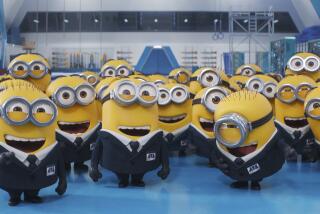How the ‘Babe’ Sequel Butchered the Image of Cuddly Screen Hero
- Share via
Babe, we hardly knew ye.
Before Universal released “Babe: Pig in the City” three weeks ago, the heartwarming porker seemed a good bet for knighthood as a pop culture icon--maybe not on the magnitude of a Miss Piggy or Mickey Mouse, but a sweet figure bearing a message of tolerance and goodwill toward all living creatures--just the sort of safe, somewhat innocuous image you could project onto any and all manner of media.
But now, amid a disappointing performance at the box office (the film had grossed $13.6 million as of last weekend, finishing ninth its third week out) and a groundswell of opinion that director George Miller’s movie is disconcertingly darker than the original, “Babe” is being held up as the franchise-that-might-have-been. And the icon-that-almost-was.
“They toppled the Babe icon,” said Faith Popcorn, the trend-watching consultant and author of “The Popcorn Report” and “Clicking: 16 Trends to Future Fit Your Life, Your Work and Your Business.”
By moving the pig to the city and having him encounter city problems (brutality, mayhem), the filmmakers did more than throw a curveball at audiences, Popcorn says--they stripped Babe of his iconic status.
“Babe was a loving, courageous icon, and they gave Babe a hopeless, depressing, unfathomable hurdle to jump. . . . It’s a cruel and brutal and cynical movie. When [everyone] is looking for connection or spirit, it has no hope. It has kittens saying, ‘I’m hungry.’ ”
Dubbed the “Nostradamus of marketing” by Fortune magazine, Popcorn forecasts trends for the business community through her company, BrainReserve. As such, she’s coined any number of buzz phrases to generalize about what the consumer culture supposedly craves.
There’s her term “down-aging” (not acting according to your age) and “pleasure revenge” (the backlash against health-consciousness), to name two.
In discussing “Pig in the City,” Popcorn employs the term “vigilante consumer”--her phrase for the savvy, finicky consumer with many entertainment possibilities to choose from and the will to rebel.
“It’s the consumer saying, ‘I’m not going to pretend to like this,’ ” Popcorn said.
A subset of the vigilante consumer is the so-called “warrior parent,” Popcorn says, using the example of the Houston woman who turned her concern over aggressive toys for kids into the purple dinosaur Barney, today a monolithic media property.
In the case of “Pig in the City,” “warrior parents” who got wind that the film wasn’t for kids had ways to show their displeasure--namely by taking their kids to see two competing films, Disney’s “A Bug’s Life” and Paramount’s “The Rugrats Movie.”
But it’s wrong-minded to assume that Babe had the stuff icons are made of, says writer Douglas Rushkoff.
“Babe was not an icon, it was a character,” said Rushkoff, author of the 1994 book “Media Virus: Hidden Agendas in Popular Culture.”
“Icons have very specific features,” he added. “The universal feature of an icon is its ability to be transposed onto any kind of culture. Mickey Mouse and Miss Piggy had that universal appeal. Babe, by being a natural world pig, prevents it from becoming an icon.”
Like Popcorn, Rushkoff is in the business of coining phrases to help us better understand our ever-expanding and pervasive mass media culture. In “Media Virus,” Rushkoff writes about how certain icons and stories have a way of becoming “media viruses,” spreading through the “datasphere” (or mass media) in the same way diseases can take hold of the body. Rushkoff’s virus analogy has less to do with decrying what’s coming through our TV sets and computer screens than with describing the pervasive power of certain media events. The video of the Rodney King beating, for instance, was a media virus, Rushkoff says. So is the Clinton-Lewinsky scandal. But Babe?
“The fact that ‘Babe’ made it to where it was is a testament to the tremendous ability of the [filmmaking]. That was a fluke in itself. But to berate it for not becoming a cultural icon is to wonder why Snapple didn’t become like Coca-Cola or Pepsi.”
Still, it’s worth noting that while “Babe” was encountering crime and other forms of malfeasance in the city, the “Rugrats” weren’t taking any chances on the big screen, wandering into the forest and introducing a new baby into the franchise.
In its four weeks out, Paramount’s “The Rugrats Movie” has grossed an estimated $73.2 million, its performance indicative of the well-oiled multimedia machine that it is, so pervasive that it’s hard to distinguish where the programming stops and the advertising starts.
While there was a three-year gap between “Babe” and its sequel, “Rugrats” rarely spends a moment outside the kid consumer consciousness, whether through the TV series, the cartoon strip, the consumer products or the stage show.
Even the 100 licensees Universal lined up for “Pig in the City” spinoff products couldn’t compete with that.
Greg Beato, a columnist for Mother Jones magazine, puts a slightly different spin on icon-making.
“The only people left who can become icons are the characters in advertising,” he said. In a recent article for the online magazine Suck, Beato elaborated: “The remarkable reach that advertising now claims, especially compared to the diminishing scope of traditional mass media, is a factor that has as much resonance for artists, authors and other cultural exhibitionists as it does for advertisers. In short, if you want to be Lucille Ball or Walter Winchell today, where do you send your resume?”
To advertisers, Beato concludes, anointing the Taco Bell Chihuahua the next Seinfeld--or at the very least the heir apparent to his widespread viewership and popularity.
Today, 20 episodes into the “Yo Quiero Taco Bell” ad campaign, the omnipresence of the fast-food-pitching dog is well-established. To preserve that omnipresence, Chuck Bennett and Clay Williams, the TBWA/Chiat Day creative team that dreamed up the campaign, are careful not to give the dog too much context, lest they jeopardize the cute dog/19-year-old regular-guy personality they’ve got going. Like Babe, the dog speaks, but unlike Babe, the filmmakers don’t invest heavily in special effects to give the animal transformative, human-like characteristics. To do so, says Bennett, would be to kill the dream world of the commercial, and by extension the iconic status of the dog.
In upcoming Taco Bell spots, the Chihuahua will be doing cute things (dialing a touch-tone phone) strutting like a guy through his “salsa-powered” neighborhood). But he won’t be speaking, Evita-like, to a crowd of peasants about any Gordita revolution.
“That was pretty close to him becoming a shill,” Bennett says. “That’s not the dog’s personality. The dog’s personality is so much simpler than that.”
So “Babe: Pig in the City” should have kept it simple?
“A sequel is expected to be different,” Bennett said of the demand on sequels to be original. “So any sequel has got a couple of strikes against it to begin with.”
More to Read
Only good movies
Get the Indie Focus newsletter, Mark Olsen's weekly guide to the world of cinema.
You may occasionally receive promotional content from the Los Angeles Times.









